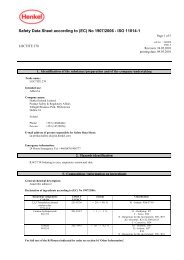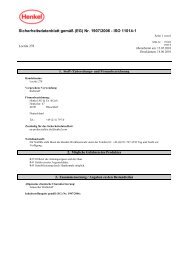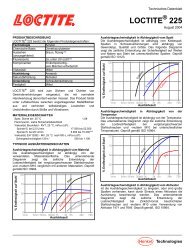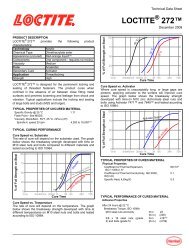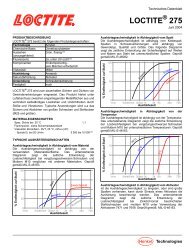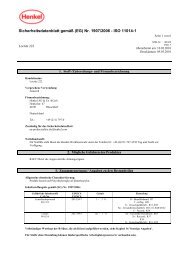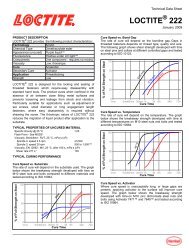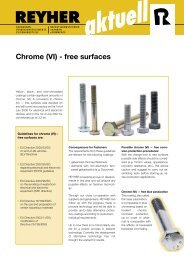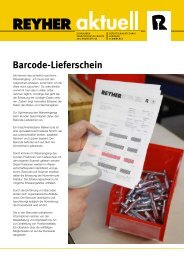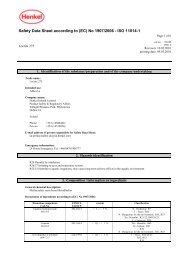„Rote Seiten“: Technische Informationen für ... - REYHER
„Rote Seiten“: Technische Informationen für ... - REYHER
„Rote Seiten“: Technische Informationen für ... - REYHER
Erfolgreiche ePaper selbst erstellen
Machen Sie aus Ihren PDF Publikationen ein blätterbares Flipbook mit unserer einzigartigen Google optimierten e-Paper Software.
Die DIN-Produkt- und Funktionsnormen <strong>für</strong> Muttern werden<br />
auf ISO-Normen umgestellt. In der Übergangszeit werden<br />
demzufolge Normen <strong>für</strong> bisherige DIN- und <strong>für</strong> neue ISO-<br />
Mutternausführungen nebeneinander im Markt sein.<br />
<strong>Informationen</strong> über Veränderungen, die die Umstellung auf<br />
internationale Normen mit sich bringt, siehe unter:<br />
„Normenumstellung DIN ➔ ISO“ Seite TiV-05<br />
Muttern werden nach drei Belastungsgruppen unterschieden –<br />
jeder Belastungsgruppe ist ein gesondertes Bezeichnungssystem<br />
<strong>für</strong> die Festigkeitsklasse zugeordnet, das die Belastungsgruppe<br />
klar erkennbar macht.<br />
1. Muttern mit Nennhöhe ≥ 0,8 D<br />
(D = Nennmaß)<br />
1.1 Muttern mit Nennhöhe ~ 0,8 D<br />
z. B. Muttern DIN 555, 934...<br />
Prüfkräfte ➔ DIN 267-4<br />
1.2 Muttern mit Nennhöhe ≥ 0,8 D<br />
z. B. Muttern ISO 4032, 8673...<br />
Prüfkräfte ➔ ISO 898-2<br />
Kennzeichnung/Erkennung: eine Zahl, z. B.<br />
(8 = 1/100 der Prüfspannung in N/mm 2 –<br />
I I = Markierung <strong>für</strong> DIN-Muttern)<br />
Diese Muttern müssen in einer Verbindung mit Schrauben<br />
der Festigkeitsklasse 8.8 die volle Ausnutzung der Vorspannung<br />
an der Streckgrenze aushalten.<br />
2. Muttern mit Nennhöhe ≥ 0,5 D < 0,8 D<br />
z. B. Muttern ISO 4035, 8675, DIN 439-2<br />
Festgelegte Prüfkräfte ➔ ISO 898-2<br />
Kennzeichnung/Erkennung: Kennzahl <strong>für</strong> 1/100<br />
der Prüfspannung mit vorgesetzter 0, z. B.<br />
Die vorgesetzte 0 zeigt an, daß Muttern dieser Gruppe<br />
die Kraft einer Schraube wegen geringer Bauhöhe nicht<br />
oder nur eingeschränkt aushalten können.<br />
3. Muttern mit Nennhöhe < 0,5 D<br />
Mutternhöhe unter 0,5 D (D = Nennmaß). In diese Gruppe<br />
fallen Muttern <strong>für</strong> leichte Verbindungen bzw. Befestigungen<br />
ohne festelegte Belasungswerte – z. B. DIN 562<br />
Bezeichnungssystem:<br />
1/10 der Mindesthärte nach Vickers, z. B.<br />
Kennzeichnung zur Identifizierung<br />
Sechskantmuttern der Belastungsgruppen 1 und 2 ab<br />
Gewindedurchmesser M 5 sind außer dem Herkunftszeichen mit<br />
einem Festigkeitsklassen-Kennzeichen zu versehen – entweder<br />
mit Zahlen entsprechend obigen Beispiel oder mit Strichsymbolen<br />
im Uhrzeigersystem. (➔ ISO 898-2 / Tab. 8)<br />
Eine Kennzeichnung von Muttern der Belastungsgruppe 3 ist nicht<br />
vorgesehen.<br />
Mechanische Eigenschaften: Muttern aus Stahl<br />
Mechanical properties: Steel nuts<br />
| 8 |<br />
8<br />
05<br />
17 H<br />
DIN-product codes and specifications for nuts are currently<br />
being adapted to ISO-standards. In the interim period therefore,<br />
product codes for existing DIN- and for new ISO-standards of<br />
nuts will exist side by side.<br />
For information on changes which will result from conversion<br />
to international standards, see „Change of standardization<br />
DIN ➔ ISO“ page TiV-05<br />
Nuts are distinguished according to three stress groups.<br />
Each stress group is allotted a separate description system<br />
for the grade, which clearly identifies the stress group.<br />
1. Nuts with nominal height ≥ 0,8 D<br />
(D = nominal diameter)<br />
1.1 Nuts with nominal height ~ 0,8 D<br />
e. g. nuts acc. DIN 555, 934...<br />
Proof load values ➔ DIN 267-4<br />
1.2 Nuts with nominal height ≥ 0,8 D<br />
e. g. nuts acc. ISO 4032, 8673...<br />
Proof load values ➔ ISO 898-2<br />
Marking/Identification: a figure, e.g.,<br />
(8 = 1/100 of the tensile strength in N/mm 2 –<br />
I I = marking for DIN-nuts)<br />
In a combination with bolts of grade 8.8, these nuts<br />
must endure full exploitation of the pre-load figures of<br />
elongation.<br />
2. Nuts with nominal height ≥ 0,5 D < 0,8 D<br />
e. g. nuts acc. ISO 4035, 8675, DIN 439-2<br />
Fixed proof load values ➔ ISO 898-2<br />
Marking/Identification: code number for 1/100 of<br />
the tensile with an 0 prefix, e. g.,<br />
The prefix 0 indicates that nuts of this group endure not<br />
or only to a limited extent the strength of a bolt on<br />
account of lower construction height.<br />
3. Nuts with nominal height < 0,5 D<br />
Nut height below 0.5 D (D = nominal diameter).<br />
This group covers nuts for light joints or fastenings<br />
without defined stress capacity – e. g. DIN 562<br />
Identification: abbreviated symbol for 1/10 of the min.<br />
hardness number according to Vickers, e. g.<br />
Marking for identification<br />
In addition to the mark of origin, hexagon nuts of group 1 und 2<br />
as from thread diameter M 5 should be marked with a grade class<br />
sign; like shown above or with symbols in clock-face-system.<br />
(➔ ISO 898-2 / table 8)<br />
No marking is required regarding nuts in group 3.<br />
TiV-29




